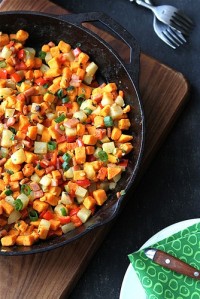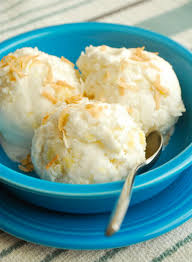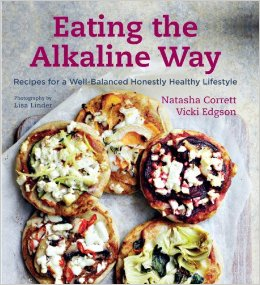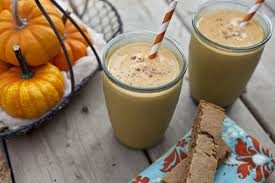Another fabulous recipe from the Alkaline Sisters!!!!
and
some awesome facts they’ve shared!
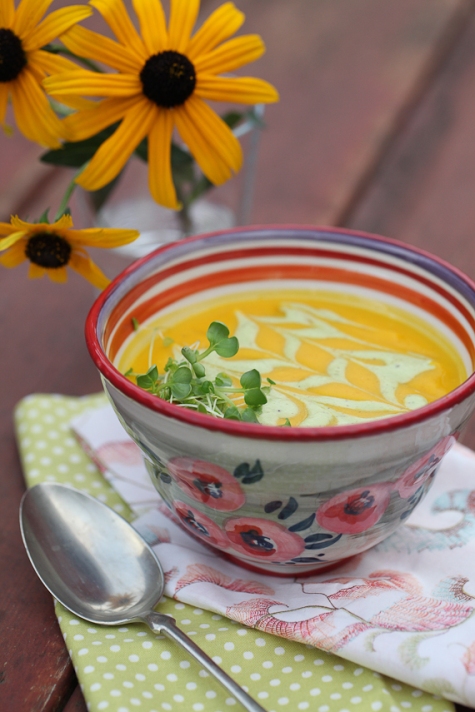
Sweet Curry Butternut Squash Soup w/ Cilantro Creme
Yield: 4 servings
1 sm-med sized organic butternut squash
1 sweet organic onion, diced
1 tsp grated fresh ginger
1 tsp fresh lemongrass, tender white portion only, finely minced
1 tbsp raw organic coconut oil
1/2 tsp garam masala
1/2 tsp organic curry powder
3/4 cup organic coconut milk
1 1/4 cup filtered water + 1/4 cup
2 dried dates, soaked for 1 hour min
Method
Carefully cut squash length wise and remove seeds. Roast cut side down in 350 degree oven on parchment paper until fork tender, approx 45-60 mins. Remove from oven, set aside to cool. Lightly saute onions in pan with coconut oil, ginger, lemongrass, garam masala and curry, adding 1/4 cup water once mixture is heated thru, simmer 1-2 mins and then remove from heat. Scoop squash into blender or food processor, add onion mixture, coconut water and dates and blend til smooth, adjusting consistency with additional water if required. Serve luke warm with Cilantro Lime creme or you may gently reheat, carefully, so as not to burn. Enjoy alongside a salad.
Cilantro Lime Creme
Yield: 3/4 cup approx
1/2 cup organic Brazil nuts, soaked 2 hours min
6 tbsp organic cilantro, roughly chopped
juice of one organic lime
1 tbsp raw organic coconut oil
1/2 cup water
1/4 tsp fine Himilayan salt
Method
Place all ingredients in a high speed blender and combine until creamy. Drizzle over soup.
Because this isn’t a raw soup, be sure to serve it with a salad to provide your dose of enzymes and living energy for this meal.
The Hard Facts I learned this week about our toxic world;
Preservatives & Additives
There are 3,000 different kinds, and none of them are safe for human consumption and they are in most everything. The average person consumes 160lbs every year! This industry is not regulated, there are recommended levels that are still not safe, but are also not being adhered to. The mandate by the powers that be is “just use what you only need to produce a product”- can you believe???
Benzidine, a yellow colour additive is one of the most lethal- the recommend use is 1 part/billion but uses have been recorded as 5 parts/billion upwards to 941 parts/billion and it is often found in children’s vitamins, candy and treats- the most susceptible age group to chemical intake. Lead is used to make most colourings and no level of lead exposure is safe.
Caramel flavour IS Amonia-eeek and GMO corn! Does not resemble food what so ever! No level of caramel flavour or colouring is safe for consumption especially for children.
30% + cases of ADD/ADHA are closely linked to the chemical toxicity of food, esp colourings; yellow #6 which contains tartrazine/coal tar, or red #40, or any “natural colouring”. These should be avoided at all costs especially by children.
Sulphites/Benzoic Acid–found to be linked to Leukemia, blood disorders
Nitrates–inhibit cells from carrying oxygen- eeek- kinda important! All processed meats have these unless indicated except baby foods.
BHA, BHT–both are known human carcinogens, cancer causing
BVO/Brominated Vegetable Oil–responsible for growth retardation, enlarged heart, thyroid issues; This chemical is accepted and used widely in Canada but has been banned everywhere else in the world!! A political move of course. Children and babies are at the highest risk.
MSG-MSG-OMG!! There are 60 different names for MSG!!! Just Google it! It is a popular flavour enhancer that has the ability to cross the blood brain barrier and kills neurons! Symptoms are headaches, vomiting, nausea, cramps and dizziness. Babies and children once again along with seniors are at the highest risk. Torula yeast is MSG-found in seemingly harmless rice chips! They were my fave until now!
Natural Sweeteners
Any thing labeled with ‘natural sweeteners” is HFCS-high fructose corn syrup, don’t trust it. Causes increase blood sugar levels and contributes to IBS- irritable bowel syndrome and many, many more terrible symptoms and disease. Stick to powdered stevia, maple syrup or dates for sweeteners.
Artificial Sweeteners
Aspartame–directly linked as a catalyst to MS/multiple sclerosis
PKU/Phenylalanie–causes severe mental retardation in babies- creates a major chemical imbalance in brain yielding depression
Methanol–causes blindness- also used for chemical warfare- how about that!!
Ace-K/Acesulfane-K-causes brain & lung tumors, leukemia
Many of these are found in DIEt pop, meant to thrill, but will kill!!!
Canola Oil– one of least favoured oils for health- Canada paid 50,000,000 dollars to pass the FDA standards!! Something fishy here don’t you think??
Pasteurization–That which is dead, cannot give you life! Pasteurized foods have been heated to kill pathogens but now the food is dead. Anything pasteurized will say Refrigerate or Best Before
Irradiation–used to kill insects, destroy micro organisms but it increase free radicals, does chromosome damage to kids
Measured by RADS- 1 RAD is equal to one chest x-ray. Potatoes receive 15,000 RADS, Flour 75,000 RADS and Spices 1,000,000 RADS!! So buy local and grow your own!
Water
Tap water is chlorinated, and has flouride & ammonia added
Distilled Water– has no minerals & is acidic
Reverse Osmosis-low in minerals
Filtered Water- strips minerals and most Chemicals
What is in our water generally, world wide;
Pharmaceuticals– passed thru our bodies end up in our water system as well as vast quantities of medicines that are flushed annually down the toilet by individuals, pharmacies and hospitals. Just recently a collection system has been devised- a little too late tho!
Vitamins–in whole or dissolved quantities, most of which are synthetically created
Bottled water leaches toxins and is generally just tap water poured into bottles including Brands like Dasani, Aquafina or Nestle so it’s very expensive tap water! In a pinch the only alkaline water with some minerals is FIJI, that’s why it costs more! Starbuck’s always carries it esp. in airports after security points when you need it most, for an incredibly dehydrating flight! Buy Two!
Take a look at this trailer on the water documentary called Tapped to believe it for yourself- you can view it on Netflicks I think or just order the DVD.
Your water needs to be: filtered, full of minerals, alkaline and ideally have an ionic charge that gives energy versus taking energy. Water should be structured so that the molecules cluster properly for optimal absorption by our bodies otherwise we just pee it out with out absorbing it, thus the reason so many people are dehydrated even tho they drink water! See my water post here.
You can easily create good drinking water by doing this.
Buy an affordable filter for your budget, the more you can afford the more it will extract, just avoid network marketing as you may end up paying more than necessary. Then either get alkaline drops for adding minerals back or use a brine of soaked Himlayan Rocks. Soak a few rocks with filered water, continuously in a jar, and add just a teaspoon to your glass of water with lemon (preferably the lemon w/rind has soaked over night in water). Next to all this you can buy an alkaline water filter and it will structure, filter and alkalize your water but they can be expensive. Prices are coming down with the supply and demand so keep your eyes open at Costco in the coming year!
That’s it for now, enough to digest I think!! Now… I seriously need to study, but thanks for the review:)


